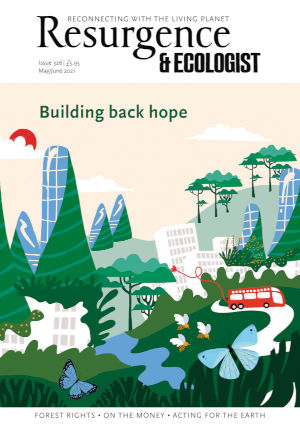In 2020, felling of ancient woodlands had begun along the planned route of the UK’s new HS2 high-speed rail line. At Jones’ Hill Wood in Buckinghamshire – the literary inspiration for Roald Dahl’s classic children’s book Fantastic Mr Fox – felling was about to start. That was until, in the face of sustained protest, legal challenges, and the discovery of a rare bat species, HS2 Ltd was legally obliged to put works on hold to conduct surveys and apply for bat licences. As bats are protected species, licences from Natural England are legally required before there can be any disturbance or damage to the woodlands in which they live.
On 30 March 2021 Natural England issued a bat licence to HS2’s contractors, allowing the works at Jones’ Hill Wood to go ahead under certain conditions. Mark Kier, from Earth Protector Communities, challenged Natural England’s decision in the High Court and on 16 April Mrs Justice Lang ordered all works to be paused pending determination of the claim or further order. However, eleven days later that decision was overturned by Mr Justice Holgate and the works resumed.
Meanwhile, across the Atlantic, judges hearing two legal claims in Ecuador’s lower courts had begun charting a course towards a new global precedent by recognising the constitutional rights of Andean cloud forests. The government of Ecuador has appealed both decisions. If the lower court decisions are upheld, this will put a stop to mining in the forest and safeguard hundreds of endangered species.
In both the UK and Ecuador, the fate of legally protected rare species and irreplaceable habitats is at stake. In both countries the state has used the law to authorise destruction and damage by corporations on grounds of national economic development. However, while there is the potential for mining in the Andean cloud forest to be stopped, without political turnaround, the HS2 woodlands may have only been given a temporary reprieve.
The difference in their fates is explained at least in part by the recognition of Rights of Nature in Ecuador’s 2008 Constitution – Ecuador was the first country in the world to bring about such vital legislation. These rights are the product of Indigenous Peoples’ and civil society mobilisation in the United States and Ecuador, which has grown into a national and global movement towards recognising Nature as a legal subject with rights. Legal activists and Indigenous Peoples, backed by the expertise of ecologists, have harnessed this movement to bring constitutional claims for Rights of Nature and Indigenous Peoples’ rights in Ecuadorian courts. The strength of this movement has proved pivotal over the course of more than a decade of Rights of Nature claims.
Against a backdrop of strong public support, a Constitutional Protection Action in favour of Rights of Nature was granted by a Cotacachi court in September 2020 to protect two rare endemic species of frog, as well as monkeys and hundreds of other species whose habitat was threatened by the Llurimagua copper mining project. This followed a decision of the Provincial Court of Imbabura in another case, which upheld the Rights of Nature of Los Cedros Protected Forest against mineral extraction. The government of Ecuador appealed both decisions. The eventual outcome will result in a global precedent on where the ultimate balance lies between the constitutional rights of a forest ecosystem and the power of the state and corporations to exploit mineral reserves for economic development.
By contrast, ancient woodlands in the UK have limited legal protection, despite their historical and cultural significance and rich biodiversity. Ancient woods and trees are recognised as “irreplaceable” in the National Planning Policy Framework. However, only a small proportion of ancient woodland is designated as a protected area. Some rare species, including bats, have the highest level of protection against damage to their habitats caused by construction. However, no law or planning policy offers guaranteed protection against state-backed infrastructure projects. These weaknesses in legal protection for Nature have enabled the UK government to exercise political discretion and proceed with HS2, despite growing public pressure and legal challenges for ancient woodlands to be saved.
Yet even constitutional recognition is no guarantee of protection. Since 2017 the government of Ecuador has actually expanded its programme of granting mining concessions. In the 2013 Cóndor Mirador case – the first Rights of Nature lawsuit brought by civil society – the appeal court upheld the state’s agenda for open-pit mining in the Amazon. This reminds us of established weaknesses in human rights law. When balancing human rights against an argument of state interest, courts have often produced decisions that defer to the state. While the Ecuadorian constitution broke new ground by enshrining Rights of Nature, until recently the majority of Rights of Nature cases have concluded in favour of state economic development interests, or favoured state-backed Rights of Nature arguments against local community activities.
Despite the turbulent journey of Rights of Nature in Ecuador, the country’s constitutional lead has created a ripple effect across South America and beyond. In New Zealand the Whanganui River, Te Urewera forest and Taranaki Maunga (formerly Mount Taranaki) have all been declared to have their own inalienable title. The state and the local Māori people have agreed joint governance arrangements in the interests of the river, forest and mountain. However, these power-sharing arrangements do not rule out entirely the potential for mineral extraction.
Law is a tool that can be taken up by the state and other powerful actors to dominate and disempower, as much as it can be used to empower and transform. The Ecuadorian experience shows that legal recognition for Rights of Nature provides no guarantee that the government will adopt policies respecting them. The New Zealand model commits to power sharing but still allows for natural resources to be exploited under certain circumstances. More than the law itself, it is public support and willingness of governments and courts to engage with law in ecologically progressive ways that shapes what happens in practice.
In 2020, when the environmental campaigner Chris Packham brought a legal challenge against the government and HS2 Ltd in the English courts, the case was dismissed essentially on the basis that it was a matter of political judgement within legal boundaries, including the UK’s climate commitments. Generally, courts have quite limited powers to intervene in government decision-making through judicial review. New ecological framings of law, such as Rights of Nature, ecocide and environmental human rights, are needed to achieve the kind of protection for Nature against the exercise of state and corporate power in the UK that has been argued for in Ecuador. However, as in New Zealand, laws need to be designed in ways that are also culturally meaningful in order to be socially and politically accepted.
At a time when we are reaching for Nature as fast as we are losing it, people and states will need to reimagine how ecological approaches to law could be developed and how power could be shared equitably between people and the state in different contexts. Rights of Nature is one possible approach, but it is not without challenges and it needs public support to be an effective legal tool. In every country and culture there is the opportunity to grow law from the spaces where human–Nature connections are being nurtured and rediscovered. Ultimately this could lead to decentring of state interests and radical shifts in legal cultures and hierarchies, recognising the diverse and interdependent nature of human–Earth relationships.
For information on Jones' Hill Wood naturalengland.blog.gov.uk/2021/03/31/bat-licensing-at-jones-hill-wood/ We will be discussing this article in our Resurgence Readers' Group on 14 May 2021. Join us here www.tickettailor.com/events/theresurgencecentre/498983/







